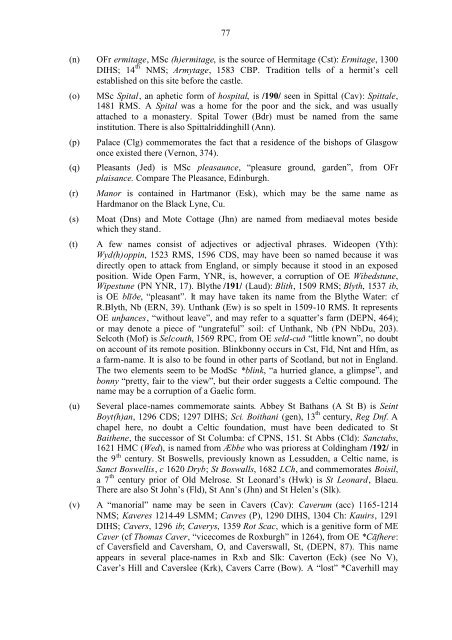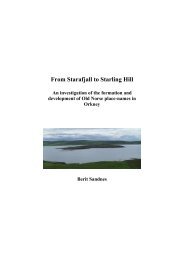May Williamson: The Non-Celtic Place-Names of the Scottish Border ...
May Williamson: The Non-Celtic Place-Names of the Scottish Border ...
May Williamson: The Non-Celtic Place-Names of the Scottish Border ...
You also want an ePaper? Increase the reach of your titles
YUMPU automatically turns print PDFs into web optimized ePapers that Google loves.
77<br />
(n) OFr ermitage, MSc (h)ermitage, is <strong>the</strong> source <strong>of</strong> Hermitage (Cst): Ermitage, 1300<br />
DIHS; 14 th NMS; Armytage, 1583 CBP. Tradition tells <strong>of</strong> a hermit’s cell<br />
established on this site before <strong>the</strong> castle.<br />
(o)<br />
(p)<br />
(q)<br />
(r)<br />
(s)<br />
(t)<br />
(u)<br />
MSc Spital, an aphetic form <strong>of</strong> hospital, is /190/ seen in Spittal (Cav): Spittale,<br />
1481 RMS. A Spital was a home for <strong>the</strong> poor and <strong>the</strong> sick, and was usually<br />
attached to a monastery. Spital Tower (Bdr) must be named from <strong>the</strong> same<br />
institution. <strong>The</strong>re is also Spittalriddinghill (Ann).<br />
Palace (Clg) commemorates <strong>the</strong> fact that a residence <strong>of</strong> <strong>the</strong> bishops <strong>of</strong> Glasgow<br />
once existed <strong>the</strong>re (Vernon, 374).<br />
Pleasants (Jed) is MSc pleasaunce, “pleasure ground, garden”, from OFr<br />
plaisance. Compare <strong>The</strong> Pleasance, Edinburgh.<br />
Manor is contained in Hartmanor (Esk), which may be <strong>the</strong> same name as<br />
Hardmanor on <strong>the</strong> Black Lyne, Cu.<br />
Moat (Dns) and Mote Cottage (Jhn) are named from mediaeval motes beside<br />
which <strong>the</strong>y stand.<br />
A few names consist <strong>of</strong> adjectives or adjectival phrases. Wideopen (Yth):<br />
Wyd(h)oppin, 1523 RMS, 1596 CDS, may have been so named because it was<br />
directly open to attack from England, or simply because it stood in an exposed<br />
position. Wide Open Farm, YNR, is, however, a corruption <strong>of</strong> OE Wibedstune,<br />
Wipestune (PN YNR, 17). Bly<strong>the</strong> /191/ (Laud): Blith, 1509 RMS; Blyth, 1537 ib,<br />
is OE blīðe, “pleasant”. It may have taken its name from <strong>the</strong> Bly<strong>the</strong> Water: cf<br />
R.Blyth, Nb (ERN, 39). Unthank (Ew) is so spelt in 1509-10 RMS. It represents<br />
OE unþances, “without leave”, and may refer to a squatter’s farm (DEPN, 464);<br />
or may denote a piece <strong>of</strong> “ungrateful” soil: cf Unthank, Nb (PN NbDu, 203).<br />
Selcoth (M<strong>of</strong>) is Selcouth, 1569 RPC, from OE seld-cuð “little known”, no doubt<br />
on account <strong>of</strong> its remote position. Blinkbonny occurs in Cst, Fld, Nnt and Hfm, as<br />
a farm-name. It is also to be found in o<strong>the</strong>r parts <strong>of</strong> Scotland, but not in England.<br />
<strong>The</strong> two elements seem to be ModSc *blink, “a hurried glance, a glimpse”, and<br />
bonny “pretty, fair to <strong>the</strong> view”, but <strong>the</strong>ir order suggests a <strong>Celtic</strong> compound. <strong>The</strong><br />
name may be a corruption <strong>of</strong> a Gaelic form.<br />
Several place-names commemorate saints. Abbey St Bathans (A St B) is Seint<br />
Boyt(h)an, 1296 CDS; 1297 DIHS; Sci. Boithani (gen), 13 th century, Reg Dnf. A<br />
chapel here, no doubt a <strong>Celtic</strong> foundation, must have been dedicated to St<br />
Bai<strong>the</strong>ne, <strong>the</strong> successor <strong>of</strong> St Columba: cf CPNS, 151. St Abbs (Cld): Sanctabs,<br />
1621 HMC (Wed), is named from Æbbe who was prioress at Coldingham /192/ in<br />
<strong>the</strong> 9 th century. St Boswells, previously known as Lessudden, a <strong>Celtic</strong> name, is<br />
Sanct Boswellis, c 1620 Dryb; St Boswalls, 1682 LCh, and commemorates Boisil,<br />
a 7 th century prior <strong>of</strong> Old Melrose. St Leonard’s (Hwk) is St Leonard, Blaeu.<br />
<strong>The</strong>re are also St John’s (Fld), St Ann’s (Jhn) and St Helen’s (Slk).<br />
(v) A “manorial” name may be seen in Cavers (Cav): Caverum (acc) 1165-1214<br />
NMS; Kaveres 1214-49 LSMM; Cavres (P), 1290 DIHS, 1304 Ch: Kauirs, 1291<br />
DIHS; Cavers, 1296 ib; Caverys, 1359 Rot Scac, which is a genitive form <strong>of</strong> ME<br />
Caver (cf Thomas Caver, “vicecomes de Roxburgh” in 1264), from OE *Cāfhere:<br />
cf Caversfield and Caversham, O, and Caverswall, St, (DEPN, 87). This name<br />
appears in several place-names in Rxb and Slk: Caverton (Eck) (see No V),<br />
Caver’s Hill and Caverslee (Krk), Cavers Carre (Bow). A “lost” *Caverhill may




